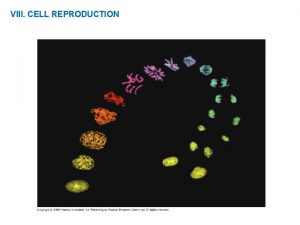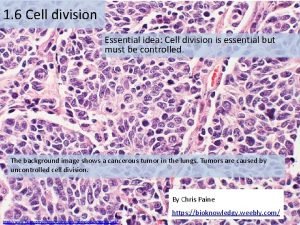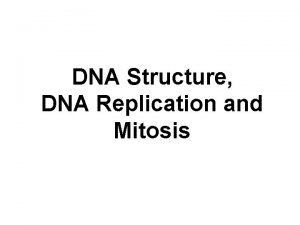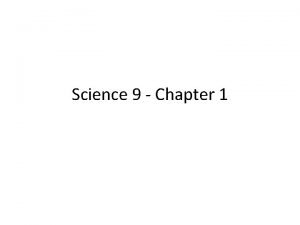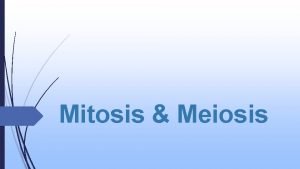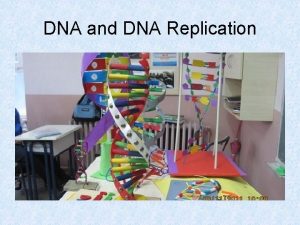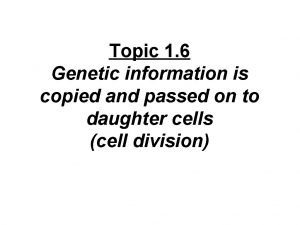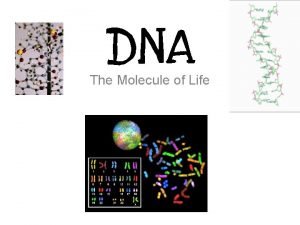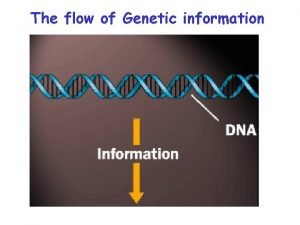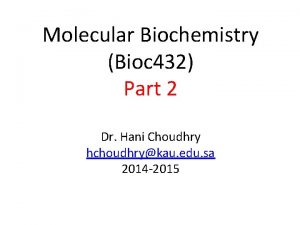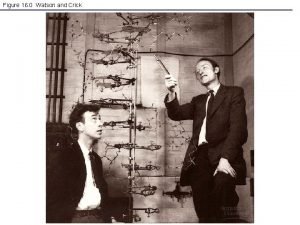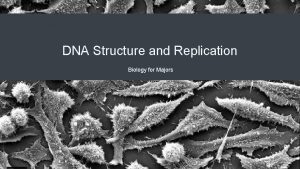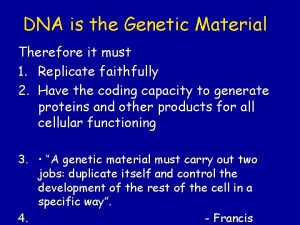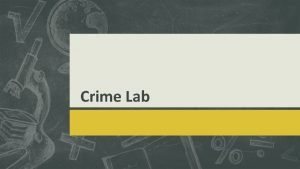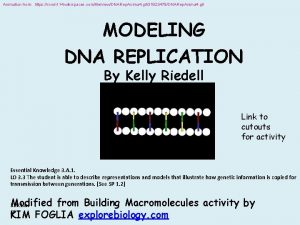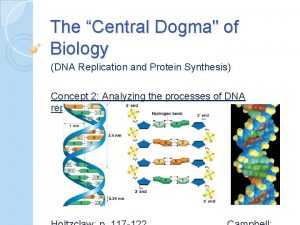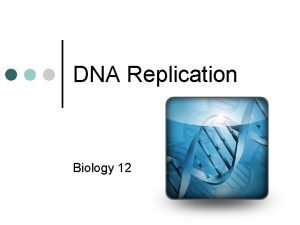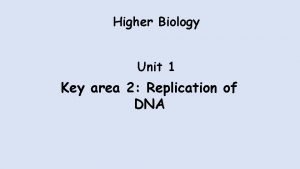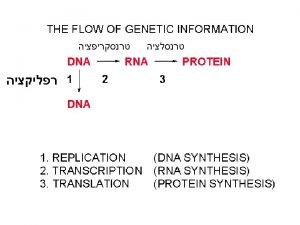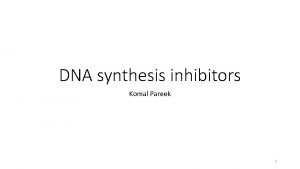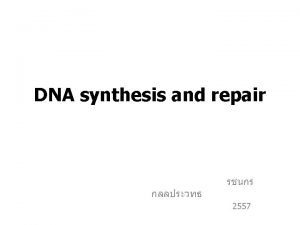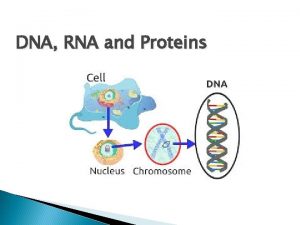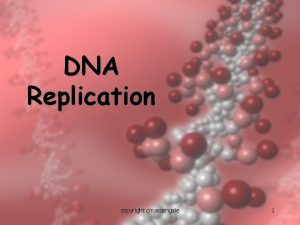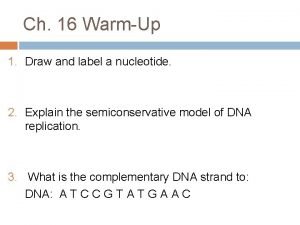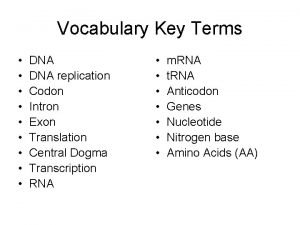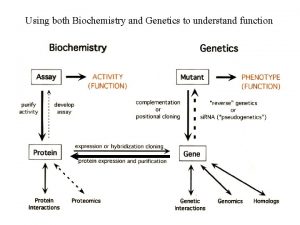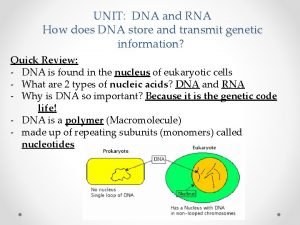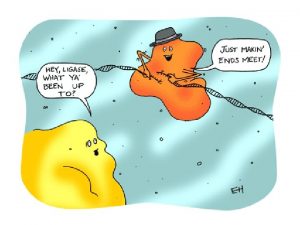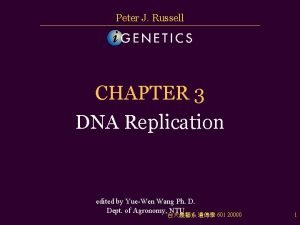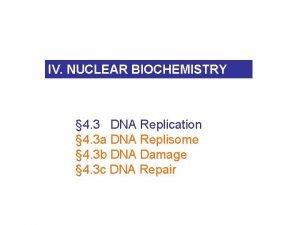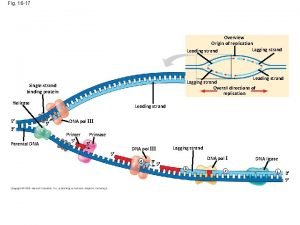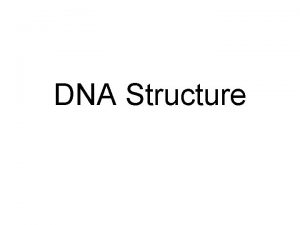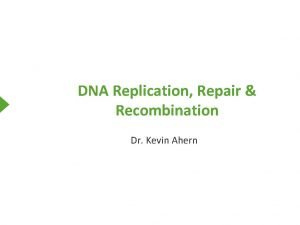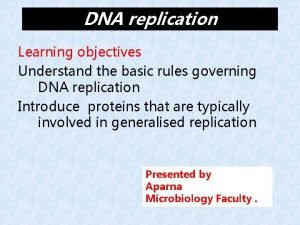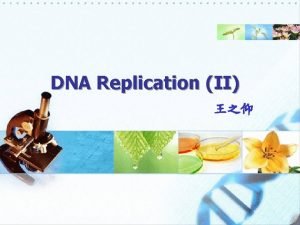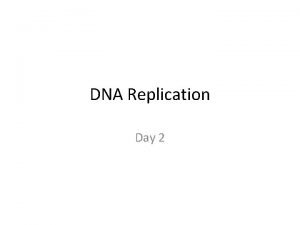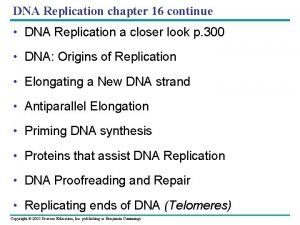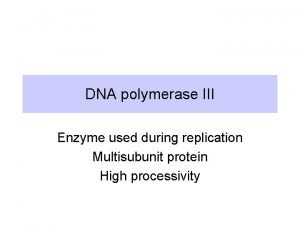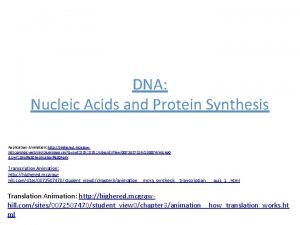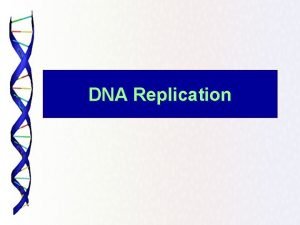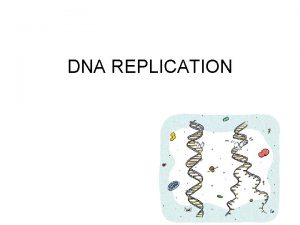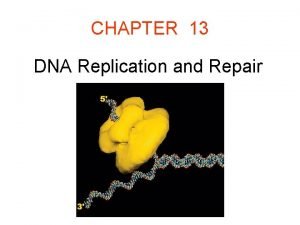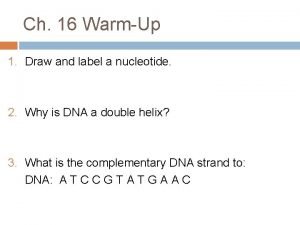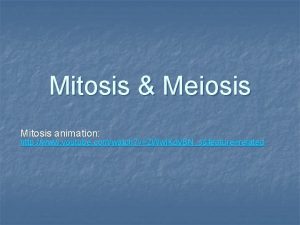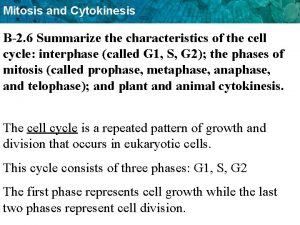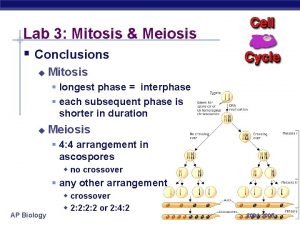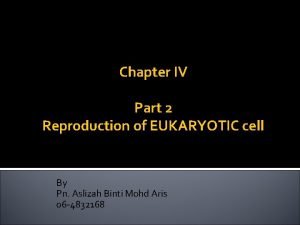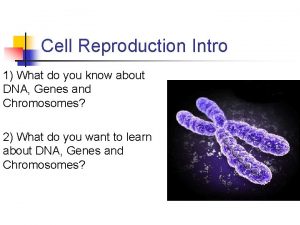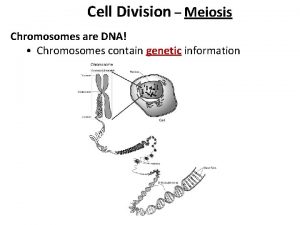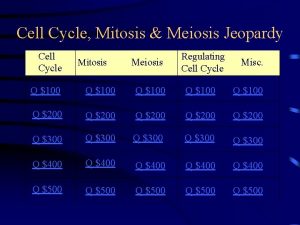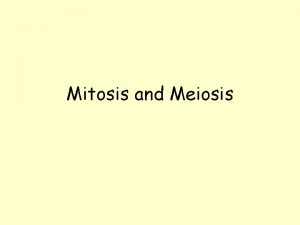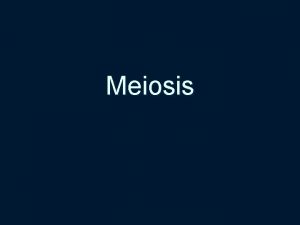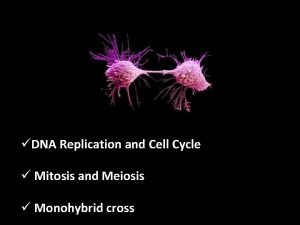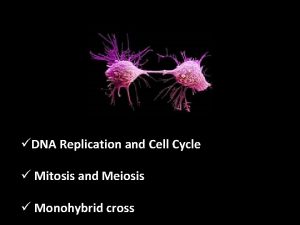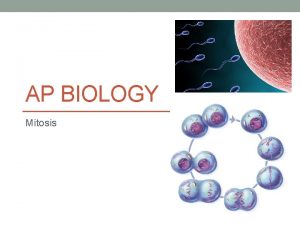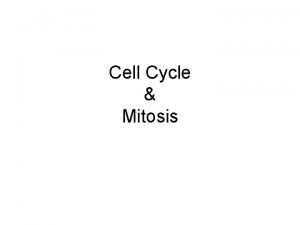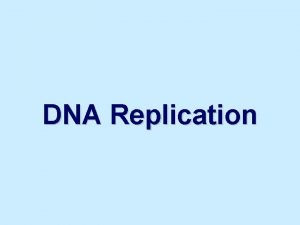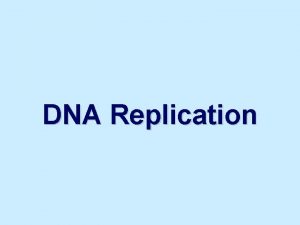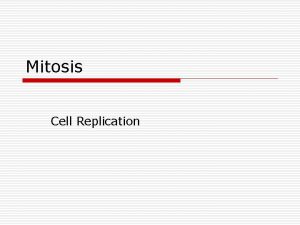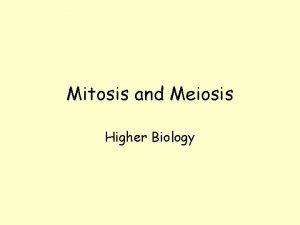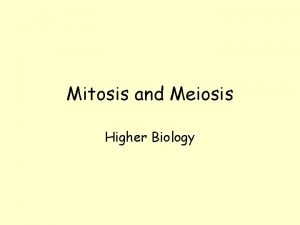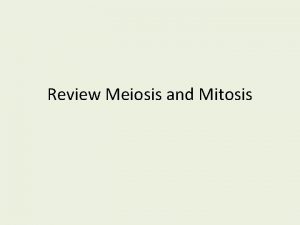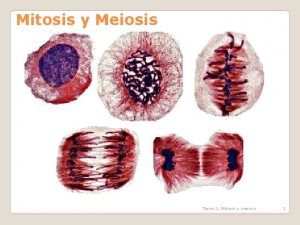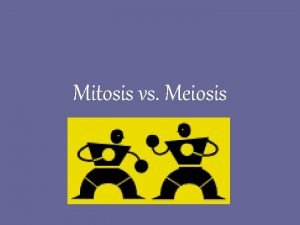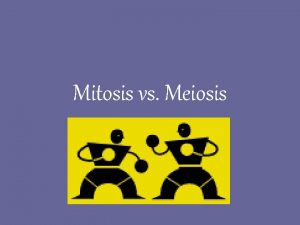DNA Replication and Cell Cycle Mitosis and Meiosis














































































- Slides: 78

üDNA Replication and Cell Cycle ü Mitosis and Meiosis ü Monohybrid and Dihybrid cross

Cell and Cell Cycle

DNA Replication http: //www. mantorlab. unimi. it/mantorlab/sito/Home. html DNA is always synthesized in the 5' to 3' direction Features of leading strand Features of lagging strand https: //www. youtube. com/watch? v=d. Kuby. IRi. N 84

http: //www. mantorlab. unimi. it/mantorlab/sito/Home. html 1. Replication of DNA molecule. Draw the new synthetized dna with the polarity of the strands and the Okazaki fragments. lagging strand 5' 3’ 5’ Okazaki Fragments 5’ 3’ 3' RNA primer leading strand 3' 5'

http: //www. mantorlab. unimi. it/mantorlab/sito/Home. html 2. How is the structure of a chromosome before and after the replication process? BEFORE AFTER Perform a scheme with the chromosome like a line and the centromere like a circle. Homologous chromosomes and sister chromatids

G 1 phase. Metabolic changes prepare the cell for division. At a certain point - the restriction point - the cell is committed to division and moves into the S phase. DNA synthesis replicates the genetic material. Each chromosome now consists of two sister chromatids. G 2 phase. Metabolic changes assemble the cytoplasmic materials necessary for mitosis and cytokinesis. M phase. A nuclear division (mitosis) followed by a cell division (cytokinesis). http: //www. mantorlab. unimi. it/mantorlab/sito/Home. html Phase M Mitosis 46 pairs of chromosomes 92 chromosomes Cell Cycle 23 pairs of chromosomes(n) 46 chromosomes Phase S Dna Synthesis Diploid cells contain two complete sets (2 n) of chromosomes. 3. Complete the scheme of cell cycle of a diploid eukaryotic cell. Draw the chromosomes at different stages of the cycle.

http: //www. mantorlab. unimi. it/mantorlab/sito/Home. html Draw a schematic picture of chromosomes of a diploid cell with n=1 In different mitosis stage. The analysed individual is heterozygous for Phase S: the chromosomes replicate themselves to gene A. A form pairs of identical sister chromosomes, or G 1/S/G 2 a chromatids. The two chromatids remain attached to one another at a region called the centromere PROPHASE A a METAPHASE ANAPHASE Daughter cells a A a a The chromosomes congregate at the equatorial plane (no pairing of homologous chromosomes). The chromatids are attached to the spindle fibers at the centromeres. A A a a The two chromatids of each chromosome separate and move to opposite poles A A a A

Meiosis: diploid cells haploid cells Tetrads; Synapsis; Recombination and Crossing over Equatorial alignment is random: independent assortment If n is 23, the possible combinations of dna in gametes are 2 n over a milion

http: //www. mantorlab. unimi. it/mantorlab/sito/Home. html Draw a schematic picture of chromosomes of a diploid cell with n=1 in different meiosis stage. The analysed individual is heterozygous for gene A. GAMETOCYTE A a Prophase I A a Phase S: The chromosomes replicate themselves to form pairs of identical sister chromosomes, or chromatids. The two chromatids remain attached to one another at a region called the centromere. Pairing of homologous chromosomes. (Recombination events) Metaphase I A a The homologous chromosomes congregate at the equatorial plane randomly. Each homologous chromosome is attached to the spindle fibers. Anaphase I The two homologous chromosomes separate and move to opposite poles A a

Anaphase I A a Telophase I A a Metaphase II The chromosomes congregate at the equatorial plane. The chromatids are attached to the spindle fibers at the centromeres. A a Anaphase II AA Gametes: 4 haploid gametes A A ½A The two chromatids of each chromosome separate and move to opposite poles a a ½a Frequency

http: //www. mantorlab. unimi. it/mantorlab/sito/Home. html Which structures migrate at the opposite poles of the spindle? a) in mitosis SISTER CHROMATIDS b) in meiosis, division I HOMOLOGOUS CHROMOSOMES c) in meiosis, division II SISTER CHROMATIDS


ü Monohybrid and Dihybrid crosses

GENETIC TERMINOLOGY Gamete: a mature reproductive cell that is specialized for sexual fusion. Each gamete is haploid and fuses with a cell of the same origin but of opposite sex to produce a diploid zygote. Cross: a mating between two individuals fusion of gametes Zygote: the cell produced by the fusion of male and female gametes Gene: the determinant of a characteristic of an organism Alleles: alternative forms of a Gene Locus: the specific place on a chromosome where a gene is located Genotype is the complete heritable genetic identity (Aa) Phenotype is a description of physical characteristics (A) Dominant character (Homozygous AA Heterozygous Aa) a mendelian character that is expressed when it is transmitted by a single alleles (upper case). Recessive Character (Homozygous aa) a mendelian character that is expressed only when transmitted by both alleles (one from each parent) determining the trait (lower case). A true-breeding organism, sometimes also called a purebred, is an organism that always passes down certain phenotypic traits (i. e. physically expressed traits) to its offspring of many generations. homozygote

http: //www. mantorlab. unimi. it/mantorlab/sito/Home. html Which types of gametes and in which proportions are produced by individuals that have the following genotypes? a) genotype AA; b) genotype Aa; c) genotype aa only GAMETES A ½ GAMETES a ONLY GAMETES a

For each cross determine genotypic and phenotypic classes expected in the progeny and relative frequencies. Genotype of the individuals used for the cross Gametes of the first individual (Frequency) Gametes of the second individual (Frequency) Genotypes and frequency of the progeny Phenotypes and frequency of the progeny AA x aa A (1) a (1) Aa (1 x 1=1) A (1) Aa x aa ½ A ½ a a (1) Aa (½ x 1= ½) aa (½ x 1= ½) A (½) a (½) ½ A ½ a A AA (½ x ½= ¼ ) (¼+2/4=3/4) Aa ( ¼ + ¼ = 2/4) aa (½ x ½= ¼ ) a (¼) Aa x Aa ½ A ½ a Monohybrid Cross Typical ratio 3: 1

A purple-flower pea plant is crossed with a white-flowered pea plant. All the F 1 plants produced purple flowers. When the F 1 plants are allowed to self-pollinate, 401 of the F 2 have purple flowers and 131 have white flowers. What are the genotypes of the parental and F 1 generation plants? Ratio in F 2 is very close to 3: 1 monohybrid cross F 1 x. F 1 cross in which both are identically heterozygous Parents differed in phenotypes F 1 only one phenotype parents were true breeding F 1 resembled one of the parental phenotypes purple is dominant over white

In dogs, hair length is determined by a gene, P, that can be present in two alternative alleles, P and p. Accordingly to the crosses reported below, determine the genotype of the individuals used for the crosses. PARENTAL PHENOTYPE a) SHORT x LONG n° OF INDIVIDUAL OF THE PROGENY SHORT HAIR LONG HAIR 100 0 PARENTAL GENOTYPE PP x pp X a) The parents have different phenotypes then different genotypes. The progeny is homogeneous (short hair) then short hair (P) is dominant over long hair (p). The parent with long hair will be homozygous recessive (pp) while the parent with short hair could be PP o Pp. b) In order to determine the genotype of the first parent I observe the phenotypes of the progeny: all individuals have short hair. Then the first parent will be homozygous dominant PP.

In dogs hair length is determined by a gene, P, that can be present in two alternative alleles, P and p. Accordingly to the crosses reported below, determine the genotype of the individuals used for the crosses. PARENTAL PHENOTYPE n° OF INDIVIDUAL OF THE PROGENY PARENTAL GENOTYPE SHORT HAIR LONG HAIR a) short x long 100 0 PP x pp b) short x long 50 50 Pp x pp X b) We have already established that short is dominant over long: the parent with long hair is homozygous recessive pp while the parent with short hair could be PP o Pp. In the progeny we have long and short hair individuals in the same proportion. The parent with the short hair will be heterozygous (Pp).

In dogs hair length is determined by a gene, P, that can be present in two alternative alleles, P and p. Accordingly to the crosses reported below, determine the genotype of the individuals used for the crosses. PARENTAL PHENOTYPE n° OF INDIVIDUAL OF THE PROGENY PARENTAL GENOTYPE SHORT HAIR LONG HAIR a) short x long 100 0 PP x pp b) short x long 50 50 Pp x pp c) short x short 150 50 Pp x Pp X c) The parents have the same phenotype (short hair) but in the progeny we have an alternative phenotype (long hair): both individuals will be heterozygous to produce homozygous recessive in the progeny pp (with frequency of ¼). Ratio 3: 1 monohybrid cross

Wild-type Drosophila melanogaster has red eyes. Mutants with purple eyes exist. This phenotype is controlled by the pr gene, which has two allelic states pr+ and pr.

This phenotype is controlled by the pr gene, which has two allelic states pr+ and pr. The following crosses have been done: Parental phenotypes n° of individuals in the progeny a) red x red Red purple total 125 35 160 Parental genotypes pr+ pr x pr+ pr b) purple x purple c) red x red d) purple x red a) Crossing two individuals with Red phenotypes we obtain individual with purple phenotype. b) The parents are heterozygous and Red is the dominant character (3/4 Red, ¼ Purple RATIO 3: 1).

This phenotype is controlled by the pr gene, which has two allelic states pr+ and pr. The following crosses have been done: Parental phenotypes n° of individuals in the progeny a) red x red b) purple x purple Red purple total Parental genotypes 125 35 160 pr+ pr x pr+ pr 0 45 45 pr pr x pr pr c) red x red d) purple x red b) In the progeny we have only purple individuals (recessive). The parents are homozygous recessive.

This phenotype is controlled by the pr gene, which has two allelic states pr+ and pr. The following crosses have been done: Parental phenotypes n° of individuals in the progeny a) red x red b) purple x purple c) red x red Red purple total Parental genotypes 125 35 160 pr+ pr x pr+ pr 0 45 45 pr pr x pr pr 177 63 240 pr+ pr x pr+ pr d) purple x red c) In the progeny we observe purple individuals. The progeny is distributed: 3/4 red ¼ purple 3: 1 The parents are heterozygous.

This phenotype is controlled by the pr gene, which has two allelic states pr+ and pr. The following crosses have been done: Parental phenotypes n° of individuals in the progeny Red purple total Parental genotypes 125 35 160 pr+ pr x pr+ pr 0 45 45 pr pr x pr pr c) red x red 177 63 240 pr+ pr x pr+ pr d) purple x red 45 55 100 pr pr x pr+ pr a) red x red b) purple x purple d) The first parent is purple thus homozygous recessive pr pr. The second parent is Red and its genotype could be pr+ o pr+ pr. In the progeny we observe individuals homozygous recessive, thus the second parent is heterozygous pr+ pr.

The major part of genes possesses more than 2 forms although all diploid individual could carry up to 2 alleles. In rabbit the colour of fur is encoded by gene C. The wild type allele C is dominant over the other alleles and correspond to a dark grey colour. The allele c h is recessive respect the wild type and if homozygous shows a Himalayan phenotype (white fur with some dark parts). The c allele is recessive respect all the previous alleles and show a phenotype totally white. We can describe the relation between alleles: C > ch > c a) White rabbit x dark gray rabbit progeny: dark gray rabbits b) Himalayan rabbit x Himalayan rabbit progeny: ¾ himalayan ¼ white c) Dark gray rabbit x white rabbit progeny: ½ dark gray ½ white d) Dark gray rabbit x Dark gray rabbit progeny: ¾ dark gray ¼ white e) Dark gray rabbit x white rabbit ½ dark gray ½ himalayan a) cc x CC b) chc x chc c) Cc x cc d) Cc x Cc e) Cch x cc

INHERITANCE OF TWO OR MORE INDEPENDENT GENES (Principle of Independent Assortment)

Draw a scheme of meiosis process of a diploid cell with n=2. One chromosome carries gene A, the other carries gene B. The analyzed individual is heterozygous for both genes. Represent the two possible relative positions of the chromosomes in metaphase I. Gametocyte A B a b FASE S (DNA replication) Prophase I Homologous chromosomes will be separated Metaphase I A B A b a B

Metaphase I A B A b a B Metaphase II A B a a b b Gametes A A B a A b a A B a ¼ AB b B ¼ ab B b b ¼ Ab a ¼ a. B


Which type of gametes and in which proportions are produced by individuals that have the following genotype (use the branch diagram)? a) aa bb b) Aa bb ab (1) A (1/2) b (1) Ab (1/2) a (1/2) b (1) ab (1/2) B (1/2) AB (1/4) b (1/2) Ab (1/4) B (1/2) a. B (1/4) b (1/2) ab (1/4) c) Aa Bb A (1/2) a (1/2)

For each cross determine genotypic and phenotypic classes expected in the progeny and relative frequencies (A and B genes are independent) genotype of the individuals used for the cross AA bb x aa BB Aa bb x aa Bb Aa Bb x aa bb Gametes of the Genotypes and second first individual frequency of the individual (frequency) progeny (frequency) Ab (1) a. B (1) Ab (1/2) a. B (1/2) ab (1/2) ¼ AB ¼ Ab ¼ a. B ¼ ab ab (1) Aa Bb (1) phenotypes and frequency of the progeny A B (1) ¼ ¼ ¼ ¼ Aa. Bb Aabb aa. Bb aabb ¼ ¼ ¼ ¼ AB Ab a. B ab

Now use the branch diagram to calculate the phenotypic classes. b) Aa bb X aa Bb Phenotypes for A gene (cross Aa X aa) A ½ ………. . . (……. ) Phenotypes for B gene (cross bb X Bb) Phenotypic classes …………. (……. . ) B ½ …………. (……. . ) AB ¼ …………. (……. . ) b ½ …………. (……. . ) B ½ …………. (……. . ) b ½ …………. (……. . ) Ab ¼ a. B ¼ a ½ ………. . . (……. ) …………. (……. . ) ab ¼

In Drosophila melanogaster, body colour is determined by the e gene: the recessive allele is responsible for the black colour of the body, the dominant allele e+ is responsible for the grey body. Vestigial wings are determined by the recessive allele vg, normal wings are determined by the dominant allele vg+. These two genes are independent. If dihybrid flies for these two genes are crossed and resulting progeny is composed by 368 individuals, how many individuals are present in every phenotypic class? e+ e+ ee vg+ vg vg Parental Genotypes: e+e vg+vg X e+e vg+vg e+ (1/2) Gametes e (1/2) vg+ (1/2) e+ vg+ (1/4) vg (1/2) e+ vg (1/4) vg+ (1/2) e vg+ (1/4) vg (1/2) e vg (1/4)

Phenotypes for gene e Phenotypes for gene vg Phenotipical classes (cross e+e X e+e) (cross vg+vg X vg+vg) vg+ (3/4) e+ (3/4) vg (1/4) e+ vg+ (¾ X ¾= 9/16) e+ vg (¾ X ¼ = 3/16) vg+ (3/4) e vg + (¾ X ¼ = 3/16) vg (1/4) e vg (¼ X ¼=1/16) e (1/4) 9/16 di 368 = 207 individuals e+ vg+ grey body and normal wings 3/16 di 368 = 69 individuals e+ vg grey body and vestigial wings 3/16 di 368 = 69 individuals e vg+ black body and normal wings 1/16 di 368 = 23 individuals e vg black body and vestigial wings

Genotypes? - Punnet square e+ vg+ 1/4 e+ vg 1/4 e vg+ 1/4 e vg 1/4

Genotypes? - Punnet square e+ vg+ 1/4 e+ vg 1/4 e vg+ 1/4 e vg 1/4 e+ vg+ 1/4 e+ e+ vg+ e+ e+ vg 1/16 e+ e vg+ vg 1/16 e+ vg 1/4 e+ e+ vg 1/16 e+ e+ vg vg 1/16 e+ e vg+ vg 1/16 e+ e vg vg 1/16 e vg+ 1/4 e+ e vg+ vg 1/16 e e vg+ vg 1/16 e vg 1/4 e+ e vg+ vg e+ e vg vg 1/16 e e vg+ vg 1/16 e e vg vg 1/16

Genotypes 1/16 of 368 = 2/16 of 368 = 1/16 of 368 = 4/16 of 368 = 2/16 of 368 = 1/16 of 368 = 23 individuals 46 individuals 23 individuals 92 individuals 46 individuals 23 individuals e+ e+ vg+ e+ e+ vg e+ e vg+ vg + e+ e+ vg vg e+ e vg+ vg e+ e vg vg e e vg+ vg e e vg vg Phenotypes 9/16 of 368 = 207 individuals e+ vg+ grey body and normal wings 3/16 of 368 = 69 individuals e+ vg grey body and vestigial wings 3/16 of 368 = 69 individuals e vg+ black body and normal wings 1/16 of 368 = 23 individuals e vg black body and vestigial wings RATIO 9: 3: 3: 1

In guinea pigs, the R gene determinates fur rough or smooth, while the B gene controls fur colour. Determine the genotype of individuals used for the crosses and verify your hypothesis with χ2 test. n° of individuals in the progeny (observed) Phenotype of individuals used for the cross Black Rough Black Smooth Brown Rough Brown Smooth a) Black Rough X Brown Smooth 50 0 b) Black Rough X Black Rough c) Black Rough X Brown Smooth d) Brown Rough X Black Rough a)The parents have different phenotypes and the progeny is all Black and Rough: - Black and Rough are dominant characters (B, black; R, rough) - The parents are homozygous: BB RR X bb rr We do not perform statistic test because we do not have differences between expected progeny and observed progeny.

In guinea pigs, the R gene determinates fur rough or smooth, while the B gene controls fur color. Determine the genotype of individuals used for the crosses and verify your hypothesis with χ2 test. n° of individuals in the progeny (observed) Phenotypes of individuals used for the cross Black Rough Black Smooth Brown Rough Brown Smooth a) Black Rough X Brown Smooth 50 0 b) Black Rough X Black Rough 185 60 57 18 c) Black Rough X Brown Smooth d) Brown Rough X Black Rough b) We know that Black and Rough are dominant traits. The crossed individuals have the same phenotype but in the progeny we have the recessive character, thus both parents are double heterozygous: Bb Rr X Bb Rr If the two genes assort independently, in the progeny we expect: 9/16 BR (Black rough): 3/16 Br (black smooth): 3/16 b. R (brown rough): 1/16 br (brown smooth)

We want to compare experimentally observed numbers of items in several different categories with numbers that are predicted on the basis of our hypothesis. It is important to understand that usually the observed phenotypic ratios among progeny rarely match exactly the expected ratios. If the difference between observed and predicted results is too large reject hypothesis C 2 (chi-square) test is used to help in making the decision to hold onto or reject the hypothesis. Phenotypes Xo (observed individuals) H (hypothesi s) Black Rough 185 9/16 Black Smooth 60 3/16 Brown Rough 57 3/16 Brown Smooth 18 1/16 Total 320 16/16 Xe Expected individuals (Xo –Xe)2 Xe

We want to compare experimentally observed numbers of items in several different categories with numbers that are predicted on the basis of our hypothesis. C 2 (chi-square) test is used to help in making the decision to hold onto or reject the hypothesis. Phenotypes Xo (observed individuals) H (hypothesi s) Xa Expected individuals Black Rough 185 9/16 Black Smooth 60 Brown Rough (Xo –Xa)2 Xa 180 (185 -180) 2= 25 25/180= 0, 14 3/16 60 0 0/60= 0 57 3/16 60 (57 -60) 2= 9 9/60=0, 15 Brown Smooth 18 1/16 20 (18 -20) 2= 4 4/20= 0, 20 Total 320 16/16 320 c 2 = 0, 49 Degrees of freedom = 4 – 1 = 3 (number of phenotypes -1) S =0, 49

5% is the conventional decision line Accepted c 2 = 0, 49 P >90%, we accept the hypotesis Rejected

In guinea pigs, the R gene determinates fur rough or smooth, while the B gene controls fur color. Determine the genotype of individuals used for the crosses and verify your hypothesis with χ2 test. n° of individuals in the progeny Phenotype of individuals used for the cross Black Rough Black Smooth Brown Rough Brown Smooth a) Black Rough X Brown Smooth 50 0 b) Black Rough X Black Rough 185 60 57 18 c) Black Rough X Brown Smooth 105 100 98 97 d) Brown Rough X Black Rough c) The parents have different phenotypes. The second parent is homozygous recessive for both genes (bb rr). The first parent has the dominant phenotypes for both characters B - R -. In the progeny we observe classes of individuals with recessive phenotypes thus the first individual is double heterozygous: Bb Rr. In the progeny we expect 4 phenotypic classes with ratio: 1: 1

c 2 Phenotypes Xo (observed individuals) H (hypothes is) Black Rough 105 ¼ Black Smooth 100 ¼ Brown Rough 98 ¼ Brown Smooth 97 ¼ Total 400 4/4 Xa Expected individuals (Xo –Xa)2 Xa

c 2 Phenotypes Xo (observed individuals) H (hypothes is) Xa Expected individuals Black Rough 105 ¼ Black Smooth 100 Brown Rough (Xo –Xa)2 Xa 100 (105 -100) 2= 25 25/100= 0, 25 ¼ 100 0 0/60= 0 98 ¼ 100 (98 -100) 2= 4 4/100=0, 04 Brown Smooth 97 ¼ 100 (97 -100) 2= 9 9/100= 0, 09 Total 400 4/4 400 c 2 = 0, 38 Degree of freedom = 4 – 1 = 3 P =>90%, we accept the hypothesis S =0, 38

In guinea pigs, the R gene determinates fur rough or smooth, while the B gene controls fur color. Determine the genotype of individuals used for the crosses and verify your hypothesis with χ2 test. n° of individuals in the progeny Phenotypes of individuals used for the cross Black Rough Black Smooth Brown Rough Brown Smooth a) Black Rough X Brown Smooth 50 0 b) Black Rough X Black Rough 185 60 57 18 c) Black Rough X Brown Smooth 105 100 98 97 d) Brown Rough X Black Rough 63 17 58 22 d) The first individual is homozygous recessive for colour (bb) and he has the dominant phenotype for Rough gene (R -). The second individual is dominant for both characters (B - R -). In the progeny we observe the classes with recessive phenotypes for brown and smooth hair, thus the original individuals have a recessive allele to donate to the progeny: b b R r X B b R r

With branch diagram determine expected phenotypic classes: Gene B bb X Bb B (1/2) b (1/2) Gene R Rr x Rr phenotypic Classes R (3/4) B R (1/2 x 3/4 = 3/8) black rough r (1/4) B r (1/2 x 1/4 = 1/8) black smooth R (3/4) b R (1/2 x 3/4 = 3/8) brown rough r (1/4) b r (1/2 x 1/4 = 1/8) brown smooth

c 2 Phenotypes Xo H (observed (hypothe individual sis) s) Black Rough 63 3/8 Black smooth 17 1/8 Brown Rough 58 3/8 Brown smooth 22 1/8 Totale 160 8/8 Xe Expected individuals (Xo –Xe)2 Xe

c 2 Phenotypes Xo (observed individuals) H Xa (hypothesi Expected s) individua ls (Xo –Xa)2 Xa Black Rough 63 3/8 60 (63 -60) 2= 9 9/60= 0, 15 Black smooth 17 1/8 20 (17 -20) 2= 9 9/20= 0, 45 Brown Rough 58 3/8 60 (58 -60) 2= 4 4/60=0, 07 Brown smooth 22 1/8 20 (22 -20) 2= 4 4/20= 0, 2 Totale 160 8/8 160 c 2 = 0, 87 Freedom of degree= 4 – 1 = 3 P =80 -90%, we accept the hypothesis S =0, 87

Determine the genotype of individuals used for the crosses and verify your hypothesis with χ2 test. For each cross create a table, according to the scheme reported below. Gene W determines Red color, gene D determines the plant height Numero di individui della progenie Phenotype of individuals used for Red White the cross tall short 120 0 45 0 a) red tall x red tall b) red tall x white short c) red tall x white short d) white tall x e) red tall x red tall a) Colour: the crossed individuals have the same phenotype but in the progeny we have also recessive phenotype individuals: both parents are heterozygous (Ww) and Red (W) is dominant over white (w). b) Height: we cannot establish which is the dominant allele since the character does not segregate. All the progeny is tall. Both parents could be recessive (dd) or D D x D - o or D - x D D

c 2 Phenotypes Xo H (observed (hypothes individuals) is) Xe Expected individuals (Xo –Xe)2 Xe Red tall 120 3/4 123, 75 (120 -123, 75) 2= 14 14/123, 75= 0, 11 White tall 45 1/4 41, 25 (45 -41, 25) 2= 14 14/41, 25= 0, 33 Total 165 4/4 165 c 2 = 0, 44 Freedom of degree = 2 – 1 = 1 P =50 -70%, we can accept the hypothesis S =0, 44

Determine the genotype of individuals used for the crosses and verify your hypothesis with χ2 test. For each cross create a table, according to the scheme reported below. Gene W determines Red colour, gene D determines the plant height n° of individuals in the progeny Phenotypes of individuals used for Red White the cross tall short tall 120 0 45 a) red tall x red tall b) red tall x white short c) red tall x white short d) white tall x e) red tall x 100 0 105 White short 0 0 red tall b) The crossing plants have two different phenotypes. In the progeny we observe plants red and white: we know that red is dominant over white thus the genotypes are W w X w w Height: since we have only tall plants we establish that tall is dominant over short. In the progeny there isn’t segregation of character then the tall plant is homozygous. The genotypes are: D D X d d

Ww DD X ww dd We expect: ½ WD (red and tall) and ½ w. D (white and tall). c 2 Phenotypes Xo H (observed (hypothes individuals) is) Xa Expected individuals (Xo –Xa)2 Xa Red tall 100 ½ 102, 5 (100 -102, 5) 2= 6, 25/102, 5= 0, 06 White tall 105 ½ 102, 5 (105 -102, 5) 2= 6, 25/102, 5= 0, 06 Total 205 2/2 205 c 2 = 0, 12 Degrees of freedom = 2 – 1 = 1 P = 70 -80%, we accept the hypothesis S =0, 12

Determine the genotype of individuals used for the crosses and verify your hypothesis with χ2 test. For each cross create a table, according to the scheme reported below. Gene W determines Red color, gene D determines the plant height n° of individuals in the progeny Phenotypes of individuals used for Red White the cross tall short tall 120 0 45 a) red tall x red tall White short 0 b) red tall x white short 100 0 105 0 c) red tall x white short 45 43 48 44 d) white tall x e) red tall x red tall c) The crossed plants have different phenotypes. In the progeny we observed segregation of the characters: we know that red is dominant over white and we assess that the cross is between a heterozygote and a homozygote recessive: W w X w w Height: Tall is dominant over short, thus also for height the cross is between a heterozygote and a homozygote recessive D d X d d

Ww. Dd X wwdd We expect 4 phenotypic classes with ratio 1 : 1 : 1. test c 2 Phenotypes Xo (observed individuals) H (hypothesis) Red tall 45 ¼ Red short 43 ¼ White tall 48 ¼ White short 44 ¼ Total 180 4/4 Xe Expected individuals (Xo –Xe)2 Xe

Ww. Dd X wwdd We expect 4 phenotypic classes with ratio 1 : 1 : 1. test c 2 Phenotypes Xo (observed individuals) H (hypothes is) Xa Expected individuals Red tall 45 ¼ Red short 43 White tall (Xo –Xa)2 Xa 45 (45 -45) 2= 0 0/45= 0 ¼ 45 (43 -45) 2= 4 4/45= 0, 09 48 ¼ 45 (48 -45) 2= 9 9/45=0, 2 White short 44 ¼ 45 (44 -45) 2= 1 1/45= 0, 02 Total 180 4/4 180 c 2 = 0, 31 Degrees of freedom = 4 – 1 = 3 P =>90%, we can accept the hypothesis S =0, 31

Determine the genotype of individuals used for the crosses and verify your hypothesis with χ2 test. For each cross create a table, according to the scheme reported below. Gene W determines Red colour, gene D determines the plant height n° of individuals in the progeny Phenotype of individuals used for Red White the cross tall short tall 120 0 45 a) red tall x red tall White short 0 b) red tall x white short 100 0 105 0 c) red tall x white short 45 43 48 44 red tall 175 67 182 58 d) white tall x e) red tall x red tall d) In the progeny recessive phenotypic classes are present. We can suppose that the cross is between: w w D d X W w D d

What are the expected phenotypic classes? Gene W ww X Ww W (1/2) w (1/2) Gene D Dd x Dd Phenotypic classes D (3/4) W D (1/2 x 3/4 = 3/8) Red Tall d(1/4) W d (1/2 x 1/4 = 1/8) Red short D (3/4) w D (1/2 x 3/4 = 3/8) White Tall d (1/4) w d (1/2 x 1/4 = 1/8) White short We expect 4 phenotypic classes: 3/8 : 1/8

Phenotype s Xo (observed individuals) H (hypothes is) Red tall 175 3/8 Red short 67 1/8 White tall 182 3/8 White short 58 1/8 Total 482 8/8 Xe Expected individuals (Xo –Xe)2 Xe

Phenotypes Xo H (observed (hypothes individual is) s) Xe Expected individuals (Xo –Xe)2 Xe Red tall 175 3/8 180, 75 (175 -180, 75) 2= 33, 06 /180, 75= 0, 18 Red short 67 1/8 60, 25 (67 -60, 25) 2= 45, 56 /60, 25= 0, 75 White tall 182 3/8 180, 75 (182 -180, 75) 2= 1, 56/180, 75=0, 1 White short 58 1/8 60, 25 (58 -60, 25) 2= 5, 06/60, 25= 0, 08 Total 482 8/8 482 c 2 = 0, 31 Degrees of freedom = 4 – 1 = 3 P =70 -80%, Hypothesis accepted S =1, 11

Determine the genotype of individuals used for the crosses and verify your hypothesis with χ2 test. For each cross create a table, according to the scheme reported below. Gene W determines Red colour, gene D determines the plant height n° of individuals in the progeny Phenotype of individuals used for Red White the cross tall short tall 120 0 45 a) red tall x red tall White short 0 b) red tall x white short 100 0 105 0 c) red tall x white short 45 43 48 44 red tall 175 67 182 58 265 92 93 28 d) white tall x e) red tall x red tall e)In the progeny we observe recessive phenotypes. The individuals must be double heterozygous: W w D d X W w D d From a dihybrid cross we expect 4 phenotypic classes: 9/16 WD (Red tall) : 3/16 Wd (Red short) : 3/16 w. D (white tall) : 1/16 wd (white short).

Phenotypes Xo (observed individuals) H (hypothes is) Red tall 265 9/16 Red short 92 3/16 White tall 93 3/16 White short 28 1/16 Total 478 16/16 Xe Expected individuals (Xo –Xe)2 Xe

Phenotypes Xo (observed individuals) H (hypothes is) Xa Expected individuals Red tall 265 9/16 Red short 92 White tall (Xo –Xa)2 Xa 268, 87 (265 -268, 87) 2= 14, 97 /268, 87= 0, 05 3/16 89, 62 (92 -89, 62) 2= 5, 66 /89, 62= 0, 06 93 3/16 89, 62 (93 -89, 62) 2= 11, 42/89, 62=0, 12 White short 28 1/16 29, 87 (28 -29, 87) 2= 3, 49/29, 87= 0, 11 Total 478 16/16 478 c 2 = 0, 34 Degrees of freedom = 4 – 1 = 3 P >90%, hypothesis accepted S =0, 34

Crossing a pure line (true breeding organism) of melons white (G gene) and spherical fruits (R gene)with another pure line of melons with yellow and flat fruits the f 1 progeny is melons with white and spherical fruits. P 1 RR GG X P 2 rr gg Rr Gg F 1 Crossing two plants of F 1 we have: 148 Plants with white and spherical fruits F 2 52 Plants with yellow and spherical fruits 49 Plants with white and flat fruits 23 Plants with yellow and flat fruits Determine the genotypes of individuals of P 1, P 2 e F 1, make the hypothesis of traits segregation and verify the results with X 2 From first cross we know that spherical is dominant over flat and white is dominant over yellow. WE decide to name R the gene that control the shape melon and G the gene that control the color melon: the first parent is homozygous dominant and the second parent is homozygous recessive. The progeny will be heterozygous for both genes.

In F 2 we have 4 phenotypic classes. This is a dihybrid cross and we expect ratio 9 : 3 : 1. test c 2. Phenotypes Xo (observed individuals) H (hypothesis ) White Spherical 148 9/16 Yellow Spherical 52 3/16 White Flat 49 3/16 Yellow Flat 23 1/16 Total 272 16/16 Xe Expected individuals (Xo –Xe)2 Xe

In F 2 we have 4 phenotypic classes. This is a dihybrid cross and we expect frequencies 9 : 3 : 1. test c 2. Phenotypes Xo (observed individuals) H (hypothesis ) Xa Expected individuals White Spherical 148 9/16 Yellow Spherical 52 White Flat (Xo –Xa)2 Xa 153 (148 -153) 2= 25 25 /153= 0, 16 3/16 51 (52 -51) 2= 1 1 /51= 0, 02 49 3/16 51 (49 -51) 2= 4 4/51=0, 08 Yellow Flat 23 1/16 17 (23 -17) 2= 36 36/17= 2, 12 Total 272 16/16 272 c 2 = 2, 38 Degrees fo freedom = 4 – 1 = 3 P=30 -50%, hypothesis accepted S =2, 38

Using the branch diagram, determine the gametes produced by individuals with the following genotype (A, B and C genes are independent): a) Aa Bb CC Gene A Aa Gene B Bb Gene C CC Gametes B (1/2) C (1) ABC (½ X 1= 1/4) b (1/2) B (1/2) C (1) Ab. C (½ X 1= 1/4) a. BC (½ X 1= 1/4) b (1/2) C (1) ab. C (½ X 1= 1/4) A (1/2) a (1/2)

b) Aa bb Cc Dd Gene A Aa A (1/2) Gene B bb b (1) Gene C Cc C (1/2) c (1/2) a (1/2) b (1) C (1/2) c (1/2) Gene D Dd Gametes D (1/2) Ab. CD (½ X 1 X ½ = 1/8) d (1/2) D (1/2) Ab. Cd (½ X 1 X ½ = 1/8) Abc. D (½ X 1 X ½ = 1/8) d (1/2) D (1/2) Abcd (½ X 1 X ½ = 1/8) ab. CD (½ X 1 X ½ = 1/8) d (1/2) D (1/2) ab. Cd (½ X 1 X ½ = 1/8) abc. D (½ X 1 X ½ = 1/8) d (1/2) abcd (½ X 1 X ½ = 1/8)

c) Aa Bb Cc Gene A Aa Gene B Bb B (1/2) A (1/2) b (1/2) a (1/2) B (1/2) b (1/2) Gene C Cc Gametes C (1/2) ABC (½ X ½ = 1/8) c (1/2) C (1/2) ABc (½ X ½ = 1/8) Ab. C (½ X ½ = 1/8) c (1/2) C (1/2) Abc (½ X ½ = 1/8) a. BC (½ X ½ = 1/8) c (1/2) C (1/2) a. Bc (½ X ½ = 1/8) ab. C (½ X ½ = 1/8) c (1/2) abc (½ X ½ = 1/8)

For the following cross, determine the phenotypic classes expected in the progeny and their frequencies (A, B and C genes are independent) Aa. Bb. Cc x aabbcc Phenotypes for Gene C Gene A Gene B Cc X cc Final Phenotypes Aa X aa Bb X bb C (1/2) ABC (½ X ½ = 1/8) B (1/2) c (1/2) ABc (½ X ½ = 1/8) A (1/2) C (1/2) Ab. C (½ X ½ = 1/8) b (1/2) c (1/2) Abc (½ X ½ = 1/8) C (1/2) a. BC (½ X ½ = 1/8) B (1/2) a (1/2) c (1/2) a. Bc (½ X ½ = 1/8) C (1/2) ab. C (½ X ½ = 1/8) b (1/2) c (1/2) abc (½ X ½ = 1/8) Which are the gametes produced by the first individual and their frequencies? Which are the Genotypes of the progeny and their frequencies?

Consider three gene pairs Aa, Bb, and Cc each of which affects a different character. In each case the upper case letter signifies the dominant allele and the lowercase letter the recessive allele. These three gene pairs assort independently of each other. Calculate the probability of obtaining: an Aa. BBCc zygote from a cross of individuals that are Aa. Bb. Cc x Aa. Bb. Cc ½ x ¼ x ½ = 1/16 an Aa. BB cc zygote from a cross of individuals that are aa. BBcc x AAbb. CC 1 x impossible an ABC phenotype from a cross of individuals that are Aa. Bb. CC x Aa. Bbcc 3/4 x 1 = 9/16 an abc phenotype from a cross of individual that are Aa. Bb. Cc x aa. Bbcc ½ x ¼ x ½ =1/16

In chickens the white plumage of the leghorn breed is dominant over coloured plumage, feathered shanks are dominant over clean shanks, and pea comb is dominant over single comb. Each of the gene pairs segregates independently. If a homozygous white, feathered, pea-combed chicken, is crossed with a homozygous coloured, clean, single-comb chicken, and the F 1 are allowed to interbreed, what proportion of the birds in the F 2 will produce only white, feathered, pea-comb progeny if mated to coloured, clean shanked, single combed birds? W white w coloured F feathered shanks f clean shanks P pea-comb p single-comb P generation: WWFFPP x ww ff pp F 1 generation: Ww Ff Pp The question is: the proportion of the birds in the F 2 that will produce only white, feathered, pea-combed progeny if mated to coloured, clean-shanked, single-combed birds(x). X= ww ff pp

W white w coloured F feathered f clean P pea-comb p single-comb P generation: WWFFPP x ww ff pp F 1 generation: Ww Ff Pp The question is: the proportion of the birds in the F 2 that will produce only white, feathered, pea-combed progeny if mated to coloured, clean-shanked, single-combed birds(x). i= ww ff pp F 3 phenotype = W F P F 1 generation: Ww Ff Pp F 2 generation: ……? ? ? ? ? …. F 3 phenotype = W F P 100% X i= ww ff pp

W white w coloured F feathered f clean P pea-comb p single-comb The question is: the proportion of the birds in the F 2 that will produce only white, feathered, pea-combed progeny if mated to coloured, clean-shanked, single-combed birds(x). F 1 generation: Ww Ff Pp F 2 generation: WW FF PP X i= ww ff pp F 3 phenotype = W F P 100% F 1 W w F 1 F f F 1 P p W WW Ww F FF Ff P PP Pp w Ww ww f Ff ff p Pp pp ¼ probability ¼ x ¼ = 1/64 ¼ probability

Genotypes Phenotypes

Two homozygous strains of corn are hybridized. They are distinguished by six different pairs of genes, all of which assort independently and produce an independent phenotypic effect. The F 1 hybrid is selfed to give an F 2. a. What is the number of possible genotypes in the F 2? b. How many of these genotypes will be homozygous at all six gene loci? c. If all gene pairs act in a dominant-recessive fashion, what proportion of the F 2 will be homozygous for all dominants? d. What proportion of the F 2 will show all dominant phenotypes? a. What is the number of possible genotypes in the F 2? 3 n n= number of genes considered 36 = 729 b. How many of these genotypes will be homozygous at all six gene loci? 2 AA BB CC DD EE FF or aa bb cc dd ee ff

c. If all gene pairs act in a dominant-recessive fashion, what proportion of the F 2 will be homozygous for all dominants? AA BB CC DD EE FF ¼ x ¼ x ¼ x ¼ = 1/4096 number of possible gametes 26 = 64 individuals in the progeny =64 x 64= 4096 d. What proportion of the F 2 will show all dominant phenotypes? ¾ x ¾ x ¾ x ¾ = 729/4096
 Bioflix activity dna replication nucleotide pairing
Bioflix activity dna replication nucleotide pairing Concept map mitosis
Concept map mitosis Replication fork
Replication fork Chapter 11 dna and genes
Chapter 11 dna and genes Cell division mitosis and meiosis
Cell division mitosis and meiosis Cell division mitosis and meiosis
Cell division mitosis and meiosis Cell of reproduction
Cell of reproduction Mitosis and cell cycle terminology
Mitosis and cell cycle terminology Cell division phases
Cell division phases Forms of dna
Forms of dna Dna structure and replication packet answer key
Dna structure and replication packet answer key Dna replication transcription and translation
Dna replication transcription and translation Dna replication
Dna replication Mitosis vs meiosis
Mitosis vs meiosis Stages of mitosis and meiosis
Stages of mitosis and meiosis Friedrich miescher discovery
Friedrich miescher discovery Pmat
Pmat Dna meaning
Dna meaning 3-5 exonuclease vs 5-3 exonuclease
3-5 exonuclease vs 5-3 exonuclease 5 enzymes responsible for dna replication
5 enzymes responsible for dna replication Polyribosomes
Polyribosomes Major enzymes in dna replication
Major enzymes in dna replication Accgtat
Accgtat Dna replication jeopardy
Dna replication jeopardy Replication fork labeled
Replication fork labeled Dna replication vs pcr
Dna replication vs pcr What process is this
What process is this Nucleoside triphosphate in dna replication
Nucleoside triphosphate in dna replication Bioflix dna replication
Bioflix dna replication Cell restaurant analogy
Cell restaurant analogy Fork dna
Fork dna Replication of dna higher biology
Replication of dna higher biology Why is dna replication considered semiconservative
Why is dna replication considered semiconservative Dna replication pearson
Dna replication pearson Direction of helicase
Direction of helicase Dna replication in bacteria occurs
Dna replication in bacteria occurs Dna replication
Dna replication Dna polymerase proofreading
Dna polymerase proofreading Dna replication comic strip
Dna replication comic strip Dna replication facts
Dna replication facts Accuracy of dna replication
Accuracy of dna replication Bioflix dna replication
Bioflix dna replication Dna replication
Dna replication Dna synthesis at replication fork
Dna synthesis at replication fork Dna replication phschool
Dna replication phschool Chapter 13-the molecular basis of inheritance
Chapter 13-the molecular basis of inheritance Significance of replication
Significance of replication Enzyme involved in dna replication
Enzyme involved in dna replication In eukaryotes dna replication occurs in
In eukaryotes dna replication occurs in Dna replication fork
Dna replication fork Dna replication
Dna replication Dna replication steps
Dna replication steps Dna primase
Dna primase Dna replication
Dna replication Orc dna replication
Orc dna replication Dna
Dna Replication fork of dna
Replication fork of dna Dna replication
Dna replication The replication bubble and antiparallel elongation
The replication bubble and antiparallel elongation Summary of dna replication
Summary of dna replication Dna replication animation mcgraw hill
Dna replication animation mcgraw hill The principle enzyme involved in dna replication is called
The principle enzyme involved in dna replication is called Dna replication fork animation
Dna replication fork animation Dna replication is considered semiconservative because
Dna replication is considered semiconservative because Bioflix dna replication
Bioflix dna replication Whats the difference between mitosis and meiosis
Whats the difference between mitosis and meiosis Kesler science mitosis and meiosis answer key
Kesler science mitosis and meiosis answer key Haploid vs diploid venn diagram
Haploid vs diploid venn diagram Mitosis meiosis animation
Mitosis meiosis animation Summarize mitosis
Summarize mitosis What is diploid and haploid
What is diploid and haploid Respirometer
Respirometer Mitosis and meiosis venn diagram
Mitosis and meiosis venn diagram Asexual and sexual reproduction venn diagram
Asexual and sexual reproduction venn diagram Chromosome sets (=n) in mitosis and meiosis
Chromosome sets (=n) in mitosis and meiosis Characteristics of mitosis and meiosis
Characteristics of mitosis and meiosis Crossing over in meiosis and mitosis
Crossing over in meiosis and mitosis Chromosome sets (=n) in mitosis and meiosis
Chromosome sets (=n) in mitosis and meiosis Differentiate between chromosome and chromatid
Differentiate between chromosome and chromatid






